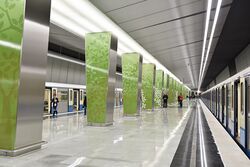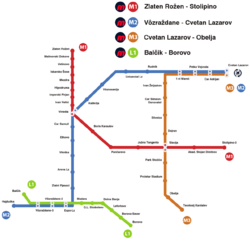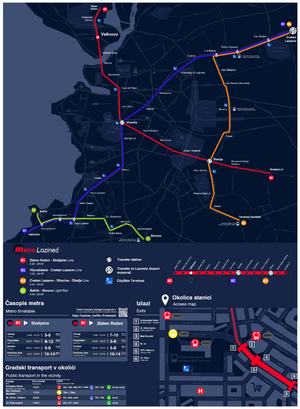Lozinetz metro
 | |||
 | |||
| Overview | |||
|---|---|---|---|
| Native name | Lozinečki metropoliten | ||
| Owner | Lozinetz Metropoliten EAD | ||
| Locale | Lozinetz, Romellea | ||
| Transit type | Rapid transit | ||
| Number of lines | 4 | ||
| Number of stations | 47 | ||
| Daily ridership | 317,000 (2019) | ||
| Chief executive | Krasimir Sergejev | ||
| Headquarters | 121, Balevurov blvd. | ||
| Website | Lozinetz traffic.rf | ||
| Operation | |||
| Began operation | 31 January 1995 | ||
| Operator(s) | Lozinetz Metropoliten EAD | ||
| Number of vehicles | 113 | ||
| Technical | |||
| System length | 36.65 km (22.8 mi) | ||
| Track gauge | 1,435 mm (4 ft 8 1⁄2 in) standard gauge | ||
| Electrification | Third rail, 825V | ||
| Average speed | 55 km/h (34 mph) | ||
| Top speed | 80 km/h (50 mph) | ||
| |||
The Lozinetz Metro (Lozinečki metropoliten, also colloquially called Lozinečko metro) is the rapid transit network servicing the Romellenic major city Lozinetz. It began operation on January 31, 1995. As of July 2019, the Lozinetz Metro consists of three interconnected subway lines and one light rail line, serving 47 stations, with a total route length of 36.65 kilometres (22.77 mi). The Metro links the densely populated districts of Zlaten Rožen – Stolipino (Line 1 – Red), Vôzraždane - Cvetan Lazarov (Line 2 - Blue), Cvetan Lazarov - Slivnica - Obelja (Line 3 - Orange) and Balčik – Borovo (Light Rail Line 1 – Light Green). The metro has a connection to a fast monorail line travelling to Lozinetz International Airport at station Cvetan Lazarov.
The Lozinetz metro system is the newest in Romellea, it was planned in the first half of the 1990s, and its construction began in 1993, with the first line being open on 31st of January 1995. Since then the subway system has been extended several times; a second line connecting the southwest and the northeast boroughs of the city was opened in 1999. In 2001, a monorail service was established between the Lozinetz International Airport and the city, with a transfer to the subway on the last station of Line M2. The new fast monorail made the access to the airport, located 25km away from the city, far easier for the majority of foreign passengers, and succeeded the older bus shuttle connection, which by early 2000s was already obsolete and overloaded.
In 2001-2003, a project for a third line operating in the eastern districts of Lozinetz was accepted, and in the course of 28 months, 13 stations were constructed. The line was opened on October 2003.
The last major extension of the rail system was made in 2009 when the boulevards Grigorij Skobelejev and Car Samuil were widened, the lines of trams 25 and 13 were separated and reconstructed into fast tram rails, and a number of shallow tunnels were constructed between the Expo-Lozinetz trade centre and Boulevard Grigorij Skobelejev. The project was converted from fast tram to light rail in 2011, and transferred under the authority of the Lozinetz Metropoliten from the city municipality. In March the line was inaugurated as the fourth and currently the last line of the system.
Since 2015, a fifth line is planned to run from the north of the city through the historical centre and the Lozinetz arena to the southeast. The line was approved and the construction of the northern branch to the centre has started in 2018. The city municipality is currently discussing the possible construction of a ring line in the centre of the city, as well as the extension of the M2 line up to the airport to reduce the load on the monorail line.
History
The liberal rule of Ivan Zhelyazkov opened Romellea to the western world for the first time since the September Revolution. In his politics, Lozinetz held a major place as the face of the country in front of the western politicians and tourists. Investitions into the city were growing, and in 1960 they had reached a mark of 7.6% of the whole income of the country. The transit system of the city was constantly upgraded, its streets and boulevards were laid with the most expensive and often imported asphalt. The public transport used both the finest domestic vehicles and even some imported western ones, something unseen on the east side of the Iron Curtain.
During the reign of Zhelyazkov, however, the city remained a historical and recreational sight, and its population did not exceed 325,000 people. Everything changed in the 1970s, with the new economic politics of xxx, when the construction of new household districts in the south began. Lozinetz experienced the same process as Samaryansk, it's population grew nearly twice in a matter of 3 years, and had reached the mark of 518,000 inhabitants in 1973. The city kept growing in the next 5 years, to eventually reach 679,000 in 1978.
Such growth showed that a new rapid transit system would be required in the next decade. The administration planned a metro system in 1977, consisting of one line connecting the historical centre with the southern boroughs of the city, with a length of 9.80 km and approximately 7 stations. The plan was approved by Sredetz and construction had to commence in 1979. The August uprisings of 1978, however, halted all plans, and the following financial instability of the early 1980s put an end to all projects not only in Lozinetz, but all around Romellea.
The city kept growing, however, with millions of Romelleans leaving the countryside in the seek for better opportunities and payment in the big cities. The population of Lozinetz reached its peak in 1986, at 723,000. Public transport became overloaded, which led to an increase in cars and the resulting air pollution. Even during the financial crisis, however, Lozinetz remained a major tourist attraction, and kept accumulating higher income than most other Romellenic regions. During the late 80s, the Romellenic government decided to attract international business into the city by moving strategic offices and factories into its vicinity. Such a move required a serious upgrade of the public transport system, thus the old metro project was revived and revised.
The project received federal status and in 1991 the first plans were presented to the public. They were approved in 1992, and in 1993 the construction of the first line began. Unlike the original plans of 1979, now the line connected two major districts in two ends of the city with its historical centre and the industrial area. Still, the line was constructed next to the old town, but not in it, due to the numerous historical layers and old sewage systems below the historical centre.
Infrastructure
Railways
Depots
Trains
Lifts and escalators
Wi-Fi and network coverage
Lines
| Line | Opened | Current Lenght | Current Number of Stations | U/C Stations | Planned Stations |
|---|---|---|---|---|---|
| M1 | 31.01.1995 | 9.6 km | 15 | 0 | 18 |
| M2 | 21.11.1999 | 11.8 km | 18 | 0 | 24 |
| M3 | 09.10.2003 | 10.3 km | 13 | 0 | 13 |
| L1 | 17.03.2011 | 4.95 km | 10 | 0 | 10 |
| M4 | U/C | 14.02 km (planned) | 0 | 9 | 27 |
Line M1 - Red
| Color | Line Bullet | Termini | Connections | Full Name | Rolling Stock | Gauge | Length km | |
|---|---|---|---|---|---|---|---|---|
| Red | 
|
Zlaten Rožen Residental area |
Stolipino-3 Residental area |
Station Vinedia to Station Slavija to |
Zlaten Rožen-Stolipino line | 
|
Standard gauge | 9.6 km |
Line M2 - Blue
| Color | Line Bullet | Termini | Connections | Full Name | Rolling Stock | Gauge | Length km | |
|---|---|---|---|---|---|---|---|---|
| Blue | 
|
Cvetan Lazarov Industrial area |
Vôzraždane Residental area |
Station Cv. Lazarov to Station Car Adrijan to Station Petko Vojvoda to Station 1-vi Mareć to Station Vinedia to Station Expo-Lozinetz to Station Vôzraždane-2 to Station Vôzraždane-3 to |
Cvetan Lazarov-Vôzraždane line | 
|
Standard gauge | 11.8 km |
Line M3 - Orange
| Color | Line Bullet | Termini | Connections | Full Name | Rolling Stock | Gauge | Length km | |
|---|---|---|---|---|---|---|---|---|
| Orange | 
|
Cvetan Lazarov Industrial area |
Obelja Residental area |
Station Cv. Lazarov to Station Car Adrijan to Station Petko Vojvoda to Station 1-vi Mareć to |
Cvetan Lazarov-Slivnica-Obelja line | 
|
Standard gauge | 9.6 km |
Line L1 - Green
| Color | Line Bullet | Termini | Connections | Full Name | Rolling Stock | Gauge | Length km | |
|---|---|---|---|---|---|---|---|---|
| Green | 
|
Balčik Recreational area |
Borovo Residental area |
Station Vôzraždane-3 to Vôzraždane-2 to Station Expo-Lz to |
Zlaten Rožen-Stolipino line | 
|
Narrow gauge | 4.95 km |
Proposed lines and extencions
Line M4
Ring Line
M2 extension to Lozinetz Airport
Light rail line extension
Upgrade of the train fleet
Travelling
Ticketing
Hours of operation
Aceessibility
Design and architecture
Stations
See also
- Lozinetz, major city in Romellea



